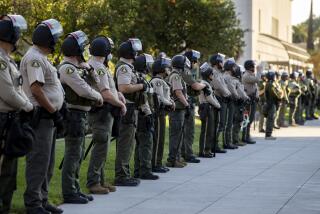Probation program is a case of constant contact
- Share via
When the description of a gold sports car fleeing a street gang fight in Adelanto cackled on his police scanner, San Bernardino County Probation Officer Nathan Scarano thought it sounded familiar.
But Scarano wasn’t certain the car belonged to Christopher Henry until he checked the computer tracking the global positioning system device strapped to Henry’s ankle.
It showed Henry leaving the June gang melee in Adelanto. And if Scarano needed any other hint, Henry’s bloodied face greeted him when Scarano knocked on his door.
“I played the hunch and sure enough, the GPS placed him at the scene,” Scarano said. “He pretty much just dipped his head and there was no argument.”
In a pilot program being closely monitored across the state and backed by Gov. Arnold Schwarzenegger, San Bernardino County officials started in April tracking certain violent gang members on probation.
Bracelets in use have located gang members during several alleged crimes, including a suspect in a slaying that occurred at a gang member’s house while he was wearing the tracking device. Officials say the devices also work to deter crimes.
“It’s a deterrent in two ways,” said Michelle Scray, San Bernardino County’s deputy chief of probation. “They are less likely to engage in illegal activity if they know they are being tracked, and other gang members won’t want to be around them if they know they are being watched.”
In May, Schwarzenegger proposed extending the San Bernardino County pilot program to 60 high-risk gang probationers in Los Angeles, Sacramento and Fresno counties. San Bernardino County officials also have asked the governor to expand its pilot program.
“We are targeting gangs inside and outside the prisons,” Schwarzenegger said at an Oakland news conference announcing intentions to expand San Bernardino County’s pilot program to other areas. “The state must coordinate the fight against gangs.”
Scray said she doubted the program would be effective statewide. The county contracts with Sentinel Offender Services to outfit its 60 gang members currently wearing the device. The probationers, as a term of their probation, are charged a daily fee for the system that is set on their ability to pay; any unpaid dues are paid by Sentinel.
“On a smaller scale, the program is doable,” Scray said. “On a larger scale I don’t know how you could do it with all of the costs.”
To select the gang members to track, probation officials give their charges risk-assessment tests to determine who is most prone to violent crimes. The tracking system can be set for inclusion zones, where the probationer can go, and exclusion zones, where he can’t. If a gang member is where he shouldn’t be, the system notifies probation officials, who are also contacted if the ankle transmitter is broken or tampered with.
The GPS system can pinpoint a probationer to a specific location, at a specific time and tell how fast he is traveling.
“It’s a deterrent when people know they are going to commit a crime and they have this thing on them, but it doesn’t actually prevent the crime,” said county Probation Director Rick Arden.
In tracking offenders, San Bernardino County has taken initiative in using technology to its benefit. It was the first county two years ago to track high-risk sex offenders with GPS; that approach has expanded to other counties, including Orange and Los Angeles.
As more Los Angeles-area gang members move to San Bernardino County, combating the violence has been a priority for the Board of Supervisors. An estimated 13,000 gang members live in the county, with a significant portion in the high desert.
The county’s GPS pilot program was co-sponsored by Supervisors Gary Ovitt and Brad Mitzelfelt and passed the board’s vote unanimously in April.
It is “one more tool to solve and deter gang-related crime in San Bernardino County,” Ovitt said. “With this program, gang members who commit crimes are going to be caught and sent back to prison.”
But not everyone agrees with the methods being used. Some activists argue that the program only creates an excuse for probationers to be released from jail early. Others say the effect is too small to celebrate.
“I don’t think it makes much of a difference,” said Emilio Amaya, executive director of the nonprofit San Bernardino Community Services Center.
“A lot of it has to do with poverty and a lack of resources. Until you take that away, in the end, the impact is not going to be very big.”
A lawsuit that may ultimately question the constitutionality of the program is being heard in Superior Court.
Adelanto resident Steven Porras, 23, on probation for assault, asked that his bracelet be removed because Probation Department officials decide who wears the bracelets without consulting courts.
“The judge in the case never ordered the GPS device,” said supervising Deputy Public Defender Mark Shoup, Porras’ lawyer. “The probation office is unilaterally making the decision on these conditions, one that should be made by a judge in court.”
The case is awaiting a ruling from the 4th District Court of Appeal, Division 2, in Victorville.
“We believe it is constitutional under the legislature,” Scray said. “After the ruling, we will comply with the court’s decision either way.”
But either way, probation officials said the tracking system helps combat crime in a technological era.
“GPS evens the playing field,” Scarano said. “It takes away the unknown factor.”
More to Read
Sign up for Essential California
The most important California stories and recommendations in your inbox every morning.
You may occasionally receive promotional content from the Los Angeles Times.













